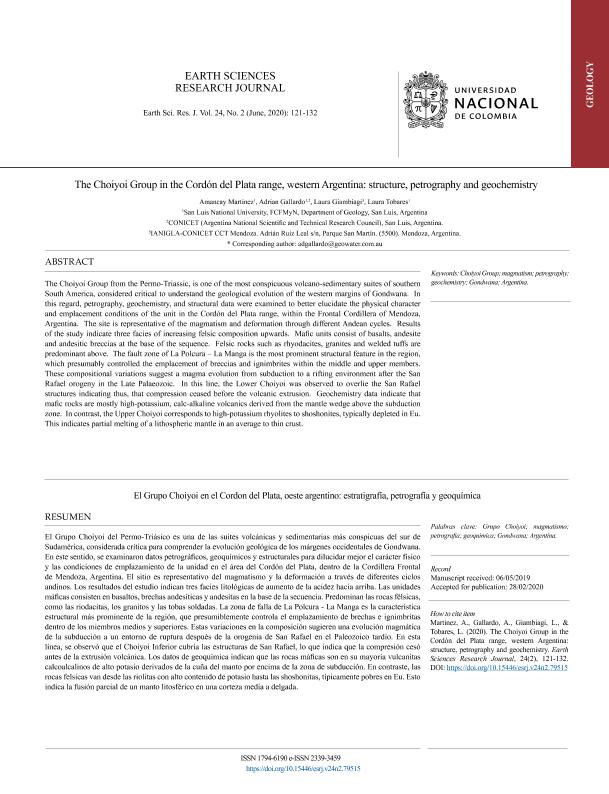Artículo
El Grupo Choiyoi del Permo-Triásico es una de las suites volcánicas y sedimentarias más conspicuas del sur de Sudamérica, considerada crítica para comprender la evolución geológica de los márgenes occidentales de Gondwana. En este sentido, se examinaron datos petrográficos, geoquímicos y estructurales para dilucidar mejor el carácter físico y las condiciones de emplazamiento de la unidad en el área del Cordón del Plata, dentro de la Cordillera Frontal de Mendoza, Argentina. El sitio es representativo del magmatismo y la deformación a través de diferentes ciclos andinos. Los resultados del estudio indican tres facies litológicas de aumento de la acidez hacia arriba. Las unidades máficas consisten en basaltos, brechas andesíticas y andesítas en la base de la secuencia. Predominan las rocas félsicas, como las riodacitas, los granitos y las tobas soldadas. La zona de falla de La Polcura - La Manga es la característica estructural más prominente de la región, que presumiblemente controla el emplazamiento de brechas e ignimbritas dentro de los miembros medios y superiores. Estas variaciones en la composición sugieren una evolución magmática de la subducción a un entorno de ruptura después de la orogenia de San Rafael en el Paleozoico tardío. En esta línea, se observó que el Choiyoi Inferior cubría las estructuras de San Rafael, lo que indica que la compresión cesó antes de la extrusión volcánica. Los datos de geoquímica indican que las rocas máficas son en su mayoría vulcanitas calcoalcalinos de alto potasio derivados de la cuña del manto por encima de la zona de subducción. En contraste, las rocas felsicas van desde las riolitas con alto contenido de potasio hasta las shoshonitas, típicamente pobres en Eu. Esto indica la fusión parcial de un manto litosférico en una corteza media a delgada. The Choiyoi Group from the Permo-Triassic, is one of the most conspicuous volcano-sedimentary suites of southern South America, considered critical to understand the geological evolution of the western margins of Gondwana. In this regard, petrography, geochemistry, and structural data were examined to better elucidate the physical character and emplacement conditions of the unit in the Cordón del Plata range, within the Frontal Cordillera of Mendoza, Argentina. The site is representative of the magmatism and deformation through different Andean cycles. Results of the study indicate three facies of increasing felsic composition upwards. Mafic units consist of basalts, andesite and andesitic breccias at the base of the sequence. Felsic rocks such as rhyodacites, granites and welded tuffs are predominant above. The fault zone of La Polcura – La Manga is the most prominent structural feature in the region, which presumably controlled the emplacement of breccias and ignimbrites within the middle and upper members. These compositional variations suggest a magma evolution from subduction to a rifting environment after the San Rafael orogeny in the Late Palaeozoic. In this line, the Lower Choiyoi was observed to overlie the San Rafael structures indicating thus, that compression ceased before the volcanic extrusion. Geochemistry data indicate that mafic rocks are mostly high-potassium, calc-alkaline volcanics derived from the mantle wedge above the subduction zone. In contrast, the Upper Choiyoi corresponds to high-potassium rhyolites to shoshonites, typically depleted in Eu. This indicates partial melting of a lithospheric mantle in an average to thin crust.
The Choiyoi Group in the Cordón del Plata range, western Argentina: structure, petrography and geochemistry
Fecha de publicación:
06/2020
Editorial:
Universidad Nacional de Colombia
Revista:
Earth Sciences Research Journal
ISSN:
1794-6190
Idioma:
Inglés
Tipo de recurso:
Artículo publicado
Clasificación temática:
Resumen
Palabras clave:
Choiyoi Group
,
Permo-Triassic extension
,
volcanism
,
pre-andean tectonics
Archivos asociados
Licencia
Identificadores
Colecciones
Articulos(IANIGLA)
Articulos de INST. ARG. DE NIVOLOGIA, GLACIOLOGIA Y CS. AMBIENT
Articulos de INST. ARG. DE NIVOLOGIA, GLACIOLOGIA Y CS. AMBIENT
Citación
Martinez, Amancay Nancy; Gallardo, Adrian Hugo; Giambiagi, Laura Beatriz; Tobares, María Laura; The Choiyoi Group in the Cordón del Plata range, western Argentina: structure, petrography and geochemistry; Universidad Nacional de Colombia; Earth Sciences Research Journal; 24; 2; 6-2020; 121-132
Compartir




